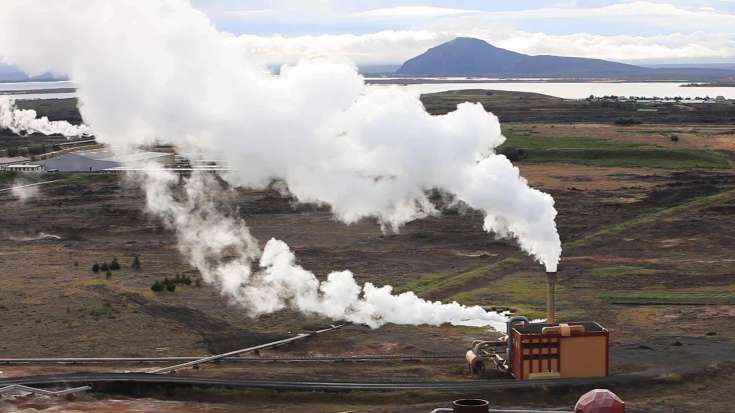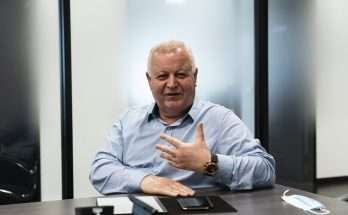A Microseismic truck in a West Texas oil field.
Microseismic
In this weekly series, CNBC takes a look at companies that made the inaugural Disruptor 50 list, 10 years later.
By 2013, when Microseismic was selected for the inaugural CNBC Disruptor 50 list, it was pretty far from the “start” in startup, already in its tenth year as a company. And that preceding decade had been one during which the company, which performs subsurface monitoring using passive seismic technology, had grown up amid the boom in U.S. oilfield hydraulic fracturing, better known as fracking, and which by 2013, was about to go bust in a major way.
When the company and its founder and CEO Peter Duncan had first raised money from investors in 2003, the idea wasn’t to ride the shale boom. Helping energy companies perform environmentally sensitive geological exploration was a core focus, with its approach more like a stethoscope, Duncan says, compared to the conventional technology of the time, seismic vibrators, which he says worked more like an ultrasound. But of all the things the company put on the list of uses for its seismic technology when it was raising money, “frac monitoring was at the bottom,” Duncan said. “We’re not going to do that,” he recalls saying. “A big red X.”
For one, there were other players already in the market, and the dominant oil services companies, including Halliburton and Baker Hughes, were buying up firms doing science similar to Microseismic – Halliburton already owned seismic mapping company Pinnacle Technologies.
And in a way, Duncan thought the science wasn’t a good match for the blunt process of oil and gas drilling. “You drill a wellbore to produce oil and gas, not to put fancy science experiments down,” he said.
Shale boom to bust
But the shale gas boom, and the market, sent a different message. “They told us to do frac monitoring, and it became more valuable to clients as they started drilling long horizontal wells that could no longer be sensed or monitored with a single down hole,” Duncan said, and Microseismic was building the equivalent of a big dish microphone up on the surface.
Its approach made Microseismic a dominant force in frac monitoring services – for a time.
“The nature of the world has changed,” Duncan said.
The Covid downturn in 2020 capped close to a decade of a bear market for oil and culminated in the negative spot prices in the oil market in May 2020. Microseismic, which had become too dependent on the shale boom, had to lay off staff and had creditors circling it. “Quite a catastrophe,” Duncan said.
And while the world has changed again, and Russia’s war in Ukraine has led to renewed focus on domestic energy supply, the oil business isn’t going back to its reckless drilling ways. Oil and gas was changing from a growth business to a value business, and oil company management were much more focused on fiscal discipline. This included decisions on where to replace reserves rather than just try to increase reserve growth on the books. “The stock market started to say, ‘we want to see oil and gas returning more money to shareholders, and so the bottom line expenditure on plays became more important than finding new reserves,” Duncan said.
A new oil production era with narrower focus
Drilling the lowest-cost well, rather than getting the most out of every possible well, became the more important benchmark, and “as long as they were getting good enough results, and could ship money to shareholders, that was good enough, and that hurt us,” Duncan said.
The business in the oilfields didn’t go away, but as drillers concentrated operations in key acreage, the seismic services were needed to protect the wells being drilled closer and closer together, which if not monitored properly could lead one well to effectively “steal” from an adjacent one, or compromise well integrity in other ways.
In the Permian Basin of Texas and New Mexico, operations were more likely to look like a “wine rack” in these post-bust days, according to Duncan, with wells at multiple levels from 2,500 to 4,000 feet and the drillers trying to get as much as they could out of every acre. That concentration of equipment and infrastructure’s resulting reduced costs was not good for an oil services company.
The seismic technology, and the interpretation of geological data, had evolved rapidly. Microseismic and competitors could predict in real time how much hydrocarbon a driller could get from a well to the point of being able to say “you should keep fracking for 15 or 20 minutes more because that’s when return on investment will be positive, and after that, it will be negative and you should turn it off,” Duncan said.
But the science getting better couldn’t change an oil sector responding to a market that wanted more capital discipline, and oil executives saying, “don’t worry about telling me how to find more oil. Just help me make sure I don’t damage adjacent well bores,” Duncan recalled.
It was the value proposition for the applied science that changed.
“They had knocked so much cost out of the system, from the [fracking] sand to drilling tech … that they didn’t care anymore about fine-tuning ROI to the nearest two decimal points,” Duncan said.
And even with the surge in oil prices after the Covid crash, this isn’t going to change. “The market has spoken. … Frac monitoring, I have to say, has become a commodity,” Duncan added.
The amount spent today is 25% of what it was in 2012, and the number of frac stages is 25% of what it was in 2012.
“The capital discipline is still there,” he said. “We put that away. We drank from the frac hose for a long time.”
Sinkholes and seismic technology
In the world of Silicon Valley startups, it’s become cliché to talk in terms of business “pivots.” But unlike a B2C app pivoting to a B2B focus on data analytics, it is less common to talk specifically about a pivot to sinkholes and geothermal energy. The underlying seismic scientific measurement approach and geology, unlike fickle consumers, allowed Microseismic to pursue new applications for its technology.
One older application of passive seismic monitoring which the company has gained traction with is listening for the development of sinkholes, taking Microseismic into the area of civil engineering. That’s become 20%-25% of the company’s income over the past few years as sites from industrial operations to residential complexes, airport runways and hotels, look to seismic monitoring as a way to spot sinkholes before catastrophe. While seismic investigations are done pre-construction to find existing sinkholes, there are opportunities for new sinkholes to develop and there had never been a standard technique for monitoring structures once built. And as environments around the world are more densely built and populated with more structures, more areas prone to sinkholes are likely to be underneath new construction. “Sinkhole detection is a global problem and we’re just trying to get our arms around it,” Duncan said.
Carbon capture and storage, and earthquakes
The pivot also took Microseismic back to a kind of work that was the first paying project it ever did: carbon sequestration in Wyoming for Anadarko Petroleum (since acquired by Occidental Petroleum), a form of oil drilling that uses CO2 called enhanced oil recovery.
As companies like Occidental Petroleum lead with a view that the climate problem isn’t about fossil fuels but emissions, CO2 sequestration is an approach that is particularly well-suited to Microseismic.
“Our science is extremely important in making CO2 sequestration work, and we are heavily pursuing it,” Duncan said. The company has a Department of Energy grant to apply the technology already in commercial use on fracking and sinkhole detection as a service for CO2 sequestration sites.
When companies put CO2 in the ground, they need to be concerned about three factors. The risk of inducing seismic events that can be damaging on the surface (think an earthquake). The risks related to a reservoir for CO2 maintaining its integrity. And the CO2 being sequestered not staying in the reservoir, leaking up above a seal or being driven down below into rock where it could cause seismic activity.
Duncan says passive seismic monitoring is an effective way to monitor for these risks and look at the dynamics of a reservoir both before and after CO2 injection. “You can hear small microseismic events growing in magnitude, and then know it might be leading to a seismic event at the surface, and you can take action to stop that,” he said. “You can detect whether a crack is forming in the seal or rock that will allow the CO2 to leak outside the reservoir, and as a plume of CO2 grows, it will create microseismic events.”
This scientific application, though, has not even hit the testing phase yet. Microseismic is still in phase one of its DOE grant focused on design of the system. Phase 2, scheduled for next spring, is to deploy on projects within the DOE-supported CarbonSafe program, several of which the Microseismic team has visited.
“At present, there is lots of talk about CO2 sequestration,” Duncan said.
And big numbers. He sees the addressable market now at 40 projects covering 20 million metric tonnes of carbon, and with a goal of growing that to a gigaton (one billion tons) of CO2 by 2030. “And that’s a huge growth industry,” he said. “And people know regulators have said you have to be able to monitor it to make sure the CO2 is staying in place and not causing earthquakes.”
There are competing ways to approach the geophysical problem, and right now it is a race to find the most economic way to perform the task.
“It feels to me like when we jumped into frac monitoring, the growth curve will be sort of like 2008-2012 over the next four years,” Duncan said.
Inflation Reduction Act, energy transition opportunities
The provisions in President Biden’s Inflation Reduction Act, and the $85 per ton in tax credits for sequestration, will help. “The talk was breakeven at $70/ton, so putting it up to $85 causes a lot of these projects to look a lot better economically,” he said.
And beyond that, there’s on the order of $2 billion in funds for testing and research related to carbon sequestration. “We are beneficiaries of that,” Duncan added.
The IRA is also putting a lot of the government’s billions behind geothermal energy, another area where Microseismic sees new use cases for its old fracking technology. Some of the recent investments in geothermal energy have been into companies porting frac procedures over to geothermal, looking for the places in the rocks where the heat exchange is suited to energy production but where explorers have not yet penetrated. “That will be natural for us to follow,” Duncan said. “In order to develop geothermal resources, they will need a good description of what the heat exchange is doing, what’s taking place,” and that includes on the Gulf Coast and in New Mexico, Nevada and California, as well as overseas in Europe and Australia. “Anywhere the rocks are hot it’s just a matter of how fast they get hot. The biggest nuclear reactor is the center of the earth,” Duncan said.
That’s all a long way from where Microseismic thought the business of its science was headed in 2003. “When we started the exit strategy was to improve the tech and sell it to a strategic buyer, a Halliburton or Schlumberger,” Duncan said. “We waited for a knock on the door.”
That knock came in 2010, but not from within the oil industry, as an auction led to a private equity deal, with the stated intention of ultimately taking Microseismic public. The company was in the process of restructuring for an IPO as the fracking market tanked, and the nature of the way oil and gas companies were run financially was changing. “And then Covid completely dashed that hope of going public,” Duncan said. “We licked our wounds and started off again.”
That does include the fracking businesses, which doubled in 2020 over 2019 as the market bounced back sharply after the brief Covid recession, and is on track to grow by another 30% this year. “It’s moving back up, but I don’t see that same growth curve as it had,” he said.
Machine learning and geology
As management in the oil and gas industry changes, and energy transition sectors are built from the ground up, Microseismic needs to be well-equipped in an area of science that isn’t in its roots: machine learning and AI. Duncan, who has been looking for a right-hand man for a long time, brought in Gary Hargraves over the summer as chief operating officer and president. Hargraves, who has digital services experience across industries including oil, mining, airlines and retail, and most recently oversaw consulting firm Capgemini’s ESG and carbon tracking data solutions, is charged with merging the traditional geophysical science of the company with the data and digital revolution, though Duncan says, “I am not in a hurry to shuffle off to Buffalo.”
He also says it’s not a stretch for the energy business to be at the forefront of computer science. “The geophysical business has been the largest user of computing throughout history,” he said. “Some of the first machines at MIT were for seismic processing.”
Geophysicists have always practiced the inverse theory of data — deriving a model from a set of physical world measurements, in a sense reversing the action of a geophysical process. “Machine learning and AI are just more sophisticated ways to do that. It’s the difference between a calculator and a computer,” Duncan said.
And as in many industries, if it works it will be better, faster and cheaper, with pattern recognition and machine learning enabling what’s already being done in seismic monitoring, and in real time, and more fully using the power embedded in the data. “These machine learning technologies give you better ways to look at the data and see what we already know, but organize it in a way that lets you communicate it to everyone else. … It’s core and necessary, but not sufficient for the future,” Duncan said.
It will be sinkholes, and carbon sequestration, and geothermal energy that will be make-or-break as the company. “We have to attack these new markets … and the machine earring and pattern recognition can allow us to do it more completely and reliably in real time,” Duncan added.
The end game after two decades
Microseismic is planning again for a potential exit within the next five years. But it is not likely to be a major oil service company. All the major service companies are pivoting to new energy transition opportunities that overlap with Microseismic’s new efforts, and that gives it the chance to prove its technology, Duncan said, but with major players choosing their bets selectively in energy transition, the ultimate end game could be breaking up the company and selling the services separately, such as sinkholes to an engineering firm, and CCS to a new energy transition company.
Whichever way it plays out, Duncan said he is most surprised that the company is still independent after two decades. And there have been a lot of surprises along the way – how the shale boom became its biggest business, followed by how quickly the science became commoditized in the oil market. And finally, surprised by the resiliency of the geophysics business and the pivot to new opportunities based on the same basic science. “I take heart from that,” he said.
Duncan says all of this maybe should not have surprised him as students in geophysical sciences have traditionally been told to not worry about what’s going on in the mining or oil and gas business specifically. What they are told is, “Concentrate on the geophysics of what you’re doing and the geophysical implications, and there will be a market for what you do,” he said.
SIGN UP for our weekly, original newsletter that goes beyond the list, offering a closer look at CNBC Disruptor 50 companies, and the founders who continue to innovate across every sector of the economy.



